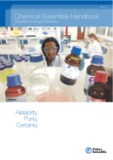Bases
Bases are usually thought of as the chemical opposite of acids. They are commonly defined as compounds that form aqueous solutions that have a high pH (>7), cause litmus paper to turn blue, and react with acids to form water and salts.
Read MoreLaboratory Reagents Handbook
The Laboratory Reagents Handbook reflects the choice of Fisher Chemical solvents and reagents available from Fisher Scientific.
Reference handbook for the analytical chemist on the bench includes:
- Over 4400 Fisher Chemical products dedicated to many analytical applications including more than 250 new products such as Optima LC/MS solvents and high purity acids for Trace Elemental analysis
- Color coded application
- Physical & Chemical data
- Hazard, packaging and storage information
- Specification
- The full Fisher BioReagents product range
- Two classifications – to simplify your searches
- Classification by applications
- Alphabetical classification
-
Chemical Essentials Handbook
Overview of our most essential products with additional storage and handling information.
- Chemical Essentials Handbook (5.8 MB)
-
Honeywell Inorganic Trace Analysis Brochure
Learn more about high-purity Honeywell Fluka TraceSELECT acids, bases, solvents, and salts for trace metal analyses.
- Honeywell Inorganic Trace Analysis Brochure (468.9 KB)







